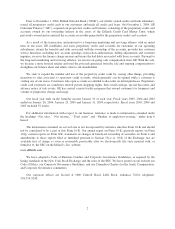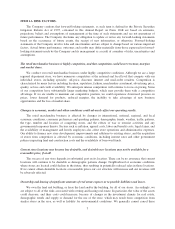Dillard's 2005 Annual Report Download - page 20
Download and view the complete annual report
Please find page 20 of the 2005 Dillard's annual report below. You can navigate through the pages in the report by either clicking on the pages listed below, or by using the keyword search tool below to find specific information within the annual report.The consumer retail sector is extremely competitive. Many different retail establishments compete for our
customers’ business. These include other department stores, specialty retailers, discounters, internet and mail
order retailers. We also attempt to enhance our income by managing our operating costs without sacrificing
service to our customers.
Items of note for the year ended January 28, 2006 include the following:
• The announcement of an American Express-branded credit card in the United States issued by GE
Consumer Finance with the first product to be offered under the new agreement to be a Dillard’s
American Express card. This agreement will supplement the long-term marketing and servicing alliance
established with GE in fiscal 2004.
• The generation of $105 million in income from the long term marketing and servicing alliance with GE.
• Decrease in interest and debt expense of $33 million compared to the year ended January 29, 2005.
• Decrease in SG&A expenses of $57 million compared to the year ended January 29, 2005.
• Cash and cash equivalents of $300 million as of January 28, 2006.
• Stock repurchases totaling $101 million during fiscal 2005.
• The repayment of debt of $157 million.
Trends and uncertainties
We have identified the following key uncertainties whose fluctuations may have a material effect on our
operating results.
• Cash flow—Cash from operating activities is a primary source of liquidity that is adversely affected
when the industry faces market driven challenges and new and existing competitors seek areas of
growth to expand their businesses. If our customers do not purchase our merchandise offerings in
sufficient quantities, we respond by taking markdowns. If we have to reduce our prices, the cost of
goods sold on our income statement will correspondingly rise, thus reducing our income.
• Success of brand—The success of our exclusive brand merchandise is dependent upon customer fashion
preferences.
• Store growth—Our growth is dependent on a number of factors which could prevent the opening of new
stores, such as identifying suitable markets and locations.
• Sourcing—Store merchandise is dependent upon adequate and stable availability of materials and
production facilities from which the Company sources its merchandise.
Legal Proceedings
On July 29, 2002, a Class Action Complaint (followed on December 13, 2004 by a Second Amended Class
Action Complaint) was filed in the United States District Court for the Southern District of Ohio against the
Company, the Mercantile Stores Pension Plan (the “Plan”) and the Mercantile Stores Pension Committee (the
“Committee”) on behalf of a putative class of former Plan participants. The complaint alleges that certain actions
by the Plan and the Committee violated the Employee Retirement Income Security Act of 1974, as amended,
(“ERISA”) as a result of amendments made to the Plan that allegedly were either improper and/or ineffective and
as a result of certain payments made to certain beneficiaries of the Plan that allegedly were improperly calculated
and/or discriminatory on account of age. The Second Amended Complaint does not specify any liquidated
amount of damages sought and seeks recalculation of certain benefits paid to putative class members. No trial
date has been set.
The Company is defending the litigation vigorously and has named the Plan’s actuarial firm as a cross
defendant. While it is not feasible to predict or determine the ultimate outcome of the pending litigation,
12
























